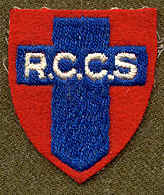|
|
Miscellaneous and Foreign Formation Insignia
There were several other Formation Patches
used by Canadian Forces serving abroad, outside the brigade, division, corps and army
patches.1
Z FORCE -
ICELAND
Troops serving in "Z Force" as
part of the Iceland garrison wore a black patch with white polar bear. This
patch was the divisional formation patch of the 49th (West Riding) Division
of the British Army. The patch was to be removed by Canadian troops after
leaving Iceland but some may have been worn by troops later serving in the
UK.2
The patch worn by Canadians was an early pattern, with the polar bear
looking down; the British divisional commander later altered the patch so
the bear looked more 'aggressive.'
|
 |
W FORCE - NEWFOUNDLAND
Troops serving in Newfoundland came under the
command of "W Force"; according to Clive Law in his book DISTINGUISHING PATCHES
the suggested patch for this command (a red caribou on green background) was not approved.
D.W. Falconer in his book BATTERY FLASHES OF W.W. II shows a sample of the patch,
and two examples from Bill Alexander's collection are shown below. The suggestion
was that the patch be worn after serving 6 months in Newfoundland, on the right arm only,
and that the patches be provided "not at public expense." It is unclear
how common these patches were, or if they were actually worn.
C FORCE - HONG KONG
Soldiers who served in Hong Kong wore no
special formation patch, but when the survivors were released from captivity, they were
given the special HK badge pictured at right to wear on their homecoming uniforms.
KISKA
Soldiers of the 13th Canadian Brigade Group
serving on Kiska wore a formation patch consisting of a knife on a blue background.
EXERCISE PATCHES
Soldiers serving on exercises in Canada late
in the war were given patches to wear. The two most commonly discussed patches were
for Exercise Eskimo and Exercise Musk-ox. |

|
CANADIAN ARMY PACIFIC FORCE
Volunteers for the Canadian Army Pacific
Force were allowed to distinguish themselves by wearing the CAPF hexagon (incorporating
the colours red, blue, french-grey, green, maroon and black) on their uniforms.
Those serving in other formations were permitted to put the CAPF hexagon overtop of the
other formation patch. This hexagon came in two sizes, large and small. The CAPF trained in the United States, and volunteers for this force were given priority on
returning to Canada from Europe after VE Day. The CAPF never saw action; the
surrender of Japan rendered their service unnecessary (they had been slated for Operation
Olympic, the invasion of the Japanese home islands.)
Badge examples below
courtesy of Bill Alexander.
| CANADIAN UNITS SERVING IN FOREIGN
FORMATIONS Some formed Canadian units
did serve in foreign formations, and wore the patches of those formations. Most
notably:
First Canadian Armoured Personnel Carrier Regiment - served
with the British 79th Armoured Division.
First Canadian Parachute Battalion - served with the British
6th Airborne Division. |
 |

Courtesy Bill Alexander.
| CANADIAN UNITS SERVING IN FOREIGN HIGHER
FORMATIONS Canadian Divisions and
Corps, as well as smaller formed units, were often part of larger British
organizations. I Canadian Corps served under the British Eighth Army in the
Mediterranean, for example, and First Canadian Army served under the British 21st Army
Group in Northwest Europe. Personnel assigned directly to Army or Army Group
Headquarters wore the formation patch for those headquarters. Units, such as signal
units, etc., that were assigned directly to the headquarters of these higher formations,
also wore the formation patch for that formation (unless assigned directly to lower
formations within that organization - ie a signal unit assigned directly to Second
Canadian Division headquarters would wear the patch of the Second Canadian Division
(only), even though technically also a part of II Canadian Corps, First Canadian Army, and
21 Army Group).
The formation patch for the British Eighth Army was a grey
shield with a golden-yellow crusader's cross. In the Mediterranean, the 16th Army
Group wore a red square with white and blue shield, and in Northwest Europe the 21st Army
Group wore a blue cross on a red shield. |

15th Army Group Patches
Courtesy Bill Alexander
|
The 8th Army flash (and also, less commonly, the
21 Army Group flash) were sometimes adopted by soldiers not otherwise entitled to wear it,
as a form of pride - often being found sewn to uniform shoulder straps.
Non unit-specific
Patches worn by 21st Army Group HQ personnel.

Courtesy Bill Alexander
SUPREME HEADQUARTERS, ALLIED
EXPEDITIONARY FORCES (SHAEF)
| The 21st Army Group came under the command of
SHAEF, the supreme Allied headquarters commanding all troops in western Europe. Rob
Dekker has passed on these photos of a Canadian officer attached to this headquarters, who
wore the Crusader's Sword insignia on his uniform. The gentleman in question joined
the Pictou Highlanders, transferred to the Canadian Intelligence Corps, and from there
went to SHAEF. He transferred to the Canadian Army Pacific Force in 1945, but was in
transit back in Canada in August 1945 when the war ended. After discharge he enjoyed
a long career with the Canadian Foreign Service, notably in South and Central America and
finishing his career as Consulate General in Atlanta, Georgia. The Battledress shows an odd mix of scarlet pips (infantry) and a
rifle green lanyard of undetermined unit. |

Courtesy Rob Dekker
|
Notes
-
Law, Clive M.
Distinguishing Patches: Formation Patches of the Canadian Army (2nd
Ed.) Service Publications, Ottawa, ON, 2008 ISBN 978-1-894581-50-9
-
Ibid p.56
|























